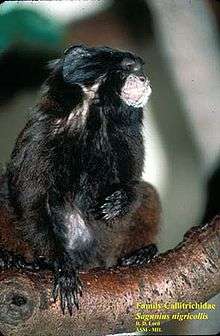Black-mantled tamarin
The black-mantled tamarin, Leontocebus nigricollis, is a species of saddle-back tamarin from the northwestern Amazon in far western Brazil, southeastern Colombia, northeastern Peru and Ecuador.[4][5]
| Black-mantled tamarin[1][2] | |
|---|---|
 | |
| Scientific classification | |
| Kingdom: | Animalia |
| Phylum: | Chordata |
| Class: | Mammalia |
| Order: | Primates |
| Suborder: | Haplorhini |
| Infraorder: | Simiiformes |
| Family: | Callitrichidae |
| Genus: | Leontocebus |
| Species: | L. nigricollis |
| Binomial name | |
| Leontocebus nigricollis (Spix, 1823) | |
 | |
| Combined range of the black-mantled and Graells's tamarins | |
- Spix's black mantle tamarin, Leontocebus nigricollis nigricollis
- Graells's tamarin or Graells’ black-mantle tamarin, Leontocebus nigricollis graellsi
- Hernandez-Camacho’s black-mantle tamarin, Leontocebus nigricollis hernandezi
Graells's tamarin has sometimes been considered to be a separate species.[6][7] The body length is 15–28 cm. The tail length is 27–42 cm.
Family groups consisting of a male, a female and 1 or 2 young live in a defined territory - the female marks branches on the boundaries of the territory with secretions of her anal glands and urine. The female gives birth to 2 young after a gestation of 140 to 150 days. It mainly eats insects, leaves, and fruit.
References
| Wikispecies has information related to Black-mantled tamarin |
- Notes
- Groves, C. P. (2005). Wilson, D. E.; Reeder, D. M. (eds.). Mammal Species of the World: A Taxonomic and Geographic Reference (3rd ed.). Baltimore: Johns Hopkins University Press. pp. 135–136. ISBN 0-801-88221-4. OCLC 62265494.
- Rylands AB, Mittermeier RA (2009). "The Diversity of the New World Primates (Platyrrhini)". In Garber PA, Estrada A, Bicca-Marques JC, Heymann EW, Strier KB (eds.). South American Primates: Comparative Perspectives in the Study of Behavior, Ecology, and Conservation. Springer. pp. 23–54. ISBN 978-0-387-78704-6.
- de la Torre, S. & Stevenson, P. (2008). "Leontocebus nigricollis". IUCN Red List of Threatened Species. 2008: e.T39945A10294823. doi:10.2305/IUCN.UK.2008.RLTS.T39945A10294823.en.
- Rylands, Anthony B.; Eckhard W. Heymann; Jessica Lynch Alfaro; Janet C. Buckner; Christian Roos; Christian Matauschek; Jean P. Boubli; Ricardo Sampaio; and Russell A. Mittermeier (2016). "Taxonomic Review of the New World Tamarins (Primates: Callitrichidae)" (PDF). Zoological Journal of the Linnean Society. 177 (4): 1003–1028. doi:10.1111/zoj.12386. Retrieved 19 April 2020.CS1 maint: uses authors parameter (link)
- Porter, Leila M.; Dacier, Anand; Garber, Paul A. (2016). Rowe, Noel; Myers, Marc (eds.). All the World's Primates. Pogonias Press. pp. 336–337. ISBN 9781940496061.
- Rylands, Mittermeier, Coimbra-Filho, Heymann, de la Torre, Silva Jr., Kierulff, Noronha and Röhe (2008). Marmosets and Tamarins: Pocket Identification Guide. Conservation International. ISBN 978-1-934151-20-4
- Defler, T. (2004). Primates of Colombia. Conservation International. ISBN 1-881173-83-6
- Source
- Macmillan Illustrated Animal Encyclopedia
This article is issued from Wikipedia. The text is licensed under Creative Commons - Attribution - Sharealike. Additional terms may apply for the media files.
